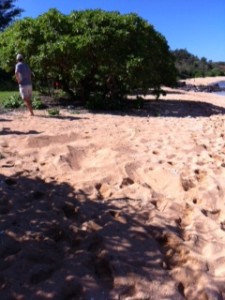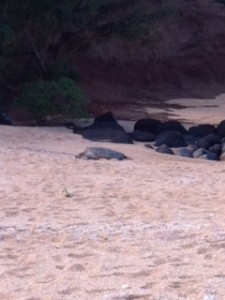Today marks the third day on Kauai and the first monk seal day. If you have been reading the previous blogs, you are aware that our time on Kauai has so far been spent hiking, taking our blood, sweat, and not so many tears (probably due to the gorgeous views and lack of falling down the steep, rocky cliffs). With our sun block and Band-Aids applied, we were ready to embark on our adventure of the day.

Before our monk seal mission began, we headed to the northernmost point of the Hawaiian Islands, Kilauea Point. Kilauea Point is home to the Kilauea Lighthouse and contains spectacular views of steep cliffs over the northern Pacific Ocean, pristine forests, and a variety of animals. As we approached the entrance gates, a Ranger informed us that if we could recite a new fact learned at the National Wildlife Refuge, we could become Junior Rangers! With our ears and eyes open, we were ready to get the most out of our experience at Kilauea Point.

Upon walking into the Refuge, we were greeted by the Hawaiian native goose, nene, as well as multiple Laysan Albatross flying over us. Kilauea Point is not only a National Wildlife Refuge, but also an Alaka’i Wilderness Preserve. Established in 1985, the National Wildlife Refuge protects seabird nesting colonies. Here, seabirds like Laysan Albatross, Red-footed Boobies, frigatebirds, and nenes are protected from its predators. The five dollar fee to enter the Refuge is donated to the US Fish and Wildlife Service to help build an anti-predator fence so that the Refuge’s seabirds can be further protected. To get a better look at the nesting seabirds, the US Fish and Wildlife Service provides binoculars. Not only did the Refuge’s visitors use the binoculars to observe the seabirds, but also to get a better look at the breaching humpback whales in the distance.
With our new learned facts in mind, we approached the Ranger prior to leaving the Refuge. Each of us recited our facts to earn us the right to be called a Junior Ranger. We recited facts on the Hawaiian names of the Laysan Albatross and monk seal, the sexual dimorphism found in Great Frigatebirds, and the three species of boobies found in the Hawaiian Islands. The Refuge proudly accepted nine new Junior Rangers and we were rewarded with nene tattoos and certificates.

Our confidence was booming as these nine Junior Rangers and their two leaders, Professor Read and TA Kenady, headed to Larsen’s Beach to find monk seals. We have not yet seen a monk seal during our trip (perhaps because there are only 200 monk seals that inhabit the Main Hawaiian Islands). Regardless of our past luck, we were eager to begin searching the beach. However, Professor Read and Kenady were not going to make it easy on us. In order to get to the beach, we needed to truck through red clay, climb down volcanic rocks, and maneuver through vegetation. Never fear, us Junior Rangers are very capable and made it to the beach without a single scratch. We were now ready to begin our mission.

Finding a Hawaiian monk seal felt more like a CSI investigation than anything else. These guys are hard to find: there are only 200 seals that mainly haul out alone and perhaps are hiding under vegetation. We needed to act as detectives and use our sense of smell and sight to zone in on their location. This task proved to be quite grueling because Larsen’s Beach is a nude beach and we needed to pass naked bodies without awkwardly staring. Besides the naked bodies, we spotted some evidence of monk seals! There were imprints of two or three monk seals along the sand as well as marks from their fore flippers. As we continued walking, we got a whiff of the seal stank. That’s when we knew we were close!



Eventually, a fellow classmate, Allison, found one hiding underneath some vegetation. This seal blended in so well that even Kenady did not notice him upon first passing the area. The class stepped back far away from the seal as Kenady got a closer look. After immediately discovering a monk seal, we call the NOAA team for instruction. From its flipper tags the Hawaiian Monk Seal Research Program, led by Charles Littnan, knew that this individual was a juvenile and molted the previous week. Unfortunately for us, we are unable to tag an animal that has recently molted. In fact, we have a lot of restrictions on individuals to tag. Sex, time of day, and time of last molt are just a few factors determining whether we are able to tag the seal. Because we could not tag this seal, we waited around hoping that this monk seal would draw some other seals onto the beach. While some of us waited around, the others had a chance to continue searching for monk seals or walk a path that leads to Laysan albatross nesting. We did not discover any other monk seals, but we did see a green sea turtle and dancing Laysan albatross.



Overall, we had a great day: we saw humpback whales, albatross, sea turtles, and monk seals. Although we were bummed that we did not find a monk seal to tag, we are hopeful that we will during the remaining days. The rest of the week will be spent on our mission to find and tag monk seals. Stay tuned to hear if we are successful in our mission.
